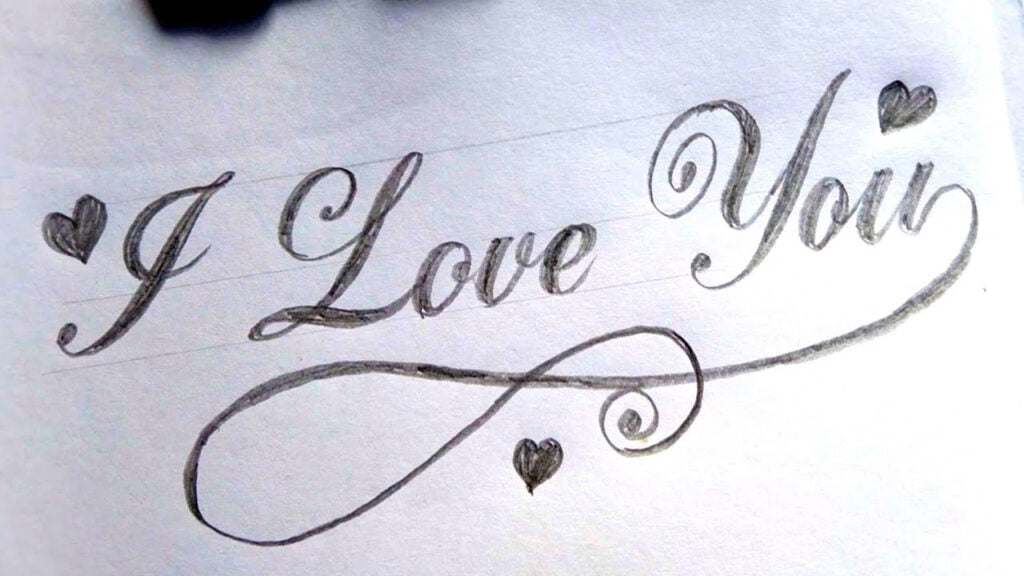Ever wondered how to write "I love you" in cursive and make it look absolutely stunning? Well, buckle up, my friend, because we're diving deep into the world of cursive writing. In this digital age, handwriting has become somewhat of a lost art, but expressing love through cursive letters brings back that personal touch that no text message or email can replicate. So, let’s explore why cursive writing matters and how you can master the art of saying "I love you" with flair.
Think about it—when was the last time you received a handwritten note? It’s rare these days, isn’t it? But that’s exactly why cursive writing has such a special place in our hearts. There's something magical about seeing those flowing letters come together to form words of affection. Whether you're writing a love letter or just trying to impress someone special, cursive writing can add that extra spark.
Now, before we dive deeper, let me tell you—this isn’t just about learning how to write "I love you" in cursive. We’re talking about understanding the nuances, mastering the strokes, and making your handwriting stand out. By the end of this article, you’ll not only know how to write those three magical words but also how to make them look like they came straight out of a romance novel.
Read also:James Harden Cutting Beard The Bold Move Thats Got Everyone Talking
Why Cursive Writing Still Matters Today
Let’s face it—most people today rely on keyboards and touchscreens for communication. But cursive writing? That’s a whole different ball game. Writing "I love you" in cursive isn’t just about putting pen to paper; it’s about creating a connection, an emotional bond that transcends time. Studies even show that handwriting stimulates parts of the brain associated with memory and creativity. So yeah, it’s more than just pretty letters—it’s personal.
Here are a few reasons why cursive writing still holds its ground:
- Personalization: Handwritten notes feel unique and special compared to typed ones.
- Emotional Impact: Cursive writing adds a level of intimacy that digital messages lack.
- Memory Boost: Writing things by hand helps retain information better.
- Cultural Heritage: Learning cursive connects us to our past and preserves tradition.
So whether you're writing "I love you" or signing your name, cursive writing brings a sense of authenticity that no emoji can replicate.
How to Write "I Love You" in Cursive Writing
Alright, let’s get down to business. Writing "I love you" in cursive might seem intimidating at first, but trust me, it’s easier than you think. The key is practice, patience, and paying attention to the flow of each letter. Here's a step-by-step guide:
Step 1: Understand the Basics of Cursive Letters
Before you start writing "I love you," take some time to familiarize yourself with basic cursive letters. Each letter has its own style, so understanding how they connect is crucial. For example:
- Lowercase i: Start with a small loop and add a dot on top.
- Lowercase l: Draw a long vertical line with a slight curve at the end.
- Lowercase o: Create a smooth, rounded oval shape.
- Lowercase v: Make two diagonal lines that meet at the bottom.
- Lowercase e: Begin with a small curve and finish with a horizontal line.
Once you’ve mastered individual letters, it’s time to combine them into words.
Read also:Ebony Rittenhouse The Rising Star You Need To Know About
Step 2: Practice Connecting Letters
Cursive writing is all about flow. To write "I love you" seamlessly, practice connecting letters together. Start slow and focus on smooth transitions between each letter. Here’s a breakdown:
- Begin with "I" and connect it to "l".
- From "l", transition smoothly to "o".
- Move on to "v" and then "e".
- Finally, finish with "you".
Don’t rush! Take your time to ensure each connection looks natural and effortless.
Tips for Mastering Cursive Writing
Mastering cursive writing takes practice, but there are a few tricks to help you along the way:
Tip #1: Use Quality Tools
Your choice of pen and paper matters. A good fountain pen or gel pen can make a huge difference in how your cursive writing looks. Plus, using high-quality paper ensures your handwriting doesn’t smudge or bleed.
Tip #2: Maintain Proper Posture
Sit up straight and hold your pen correctly. This will prevent hand fatigue and help you maintain consistent pressure while writing.
Tip #3: Practice Daily
Consistency is key. Even spending 10 minutes a day practicing cursive letters can significantly improve your skills over time.
Exploring Different Styles of Cursive Writing
Did you know there are different styles of cursive writing? From traditional Palmer Method to modern calligraphy, the options are endless. Let’s explore a few popular styles:
Style #1: Traditional Cursive
This is the classic style taught in schools. It’s simple yet elegant and perfect for beginners. Writing "I love you" in traditional cursive gives a timeless charm.
Style #2: Modern Calligraphy
Modern calligraphy adds flair to cursive writing with bold strokes and thin lines. If you want your "I love you" to pop, this style is worth exploring.
Style #3: Copperplate Script
Copperplate script is known for its intricate details and ornate designs. While it requires more practice, the results are absolutely breathtaking.
Common Mistakes to Avoid in Cursive Writing
Even the best writers make mistakes, but knowing what to avoid can save you a lot of frustration. Here are a few common pitfalls:
- Pressing Too Hard: Light pressure creates smoother lines.
- Ignoring Connections: Make sure each letter flows into the next.
- Writing Too Fast: Speed can compromise accuracy and elegance.
Remember, perfection comes with practice, so don’t be afraid to make mistakes along the way.
Benefits of Writing "I Love You" in Cursive
There’s more to cursive writing than meets the eye. Writing "I love you" in cursive offers several benefits:
Benefit #1: Emotional Connection
Handwritten notes evoke emotions that digital messages simply can’t replicate. Receiving a beautifully written "I love you" feels personal and heartfelt.
Benefit #2: Skill Development
Practicing cursive writing improves fine motor skills and hand-eye coordination. Plus, it’s a great way to unwind after a long day.
Benefit #3: Impressing Others
Let’s be honest—good handwriting is impressive. Writing "I love you" in cursive can leave a lasting impression on anyone who reads it.
Resources for Learning Cursive Writing
If you’re serious about mastering cursive writing, here are some resources to help you:
- Online Tutorials: Websites like YouTube and Skillshare offer free tutorials for beginners.
- Practice Books: Workbooks designed for cursive writing provide structured exercises.
- Community Forums: Join online communities to share tips and get feedback from fellow enthusiasts.
These resources can take your cursive writing skills to the next level, so don’t hesitate to explore them.
Real-Life Examples of Cursive Writing
Let’s look at some real-life examples of cursive writing in action:
Example #1: Love Letters
Nothing says "romance" like a beautifully written love letter. Writing "I love you" in cursive adds a touch of elegance that’s hard to resist.
Example #2: Wedding Invitations
Cursive writing is often used in wedding invitations to create a formal and sophisticated look. Imagine seeing "I love you" written in cursive on your big day—it’s a moment you’ll cherish forever.
Example #3: Artistic Designs
Artists use cursive writing to create stunning designs and illustrations. Writing "I love you" in cursive can become part of a larger masterpiece, combining words and visuals into one cohesive piece.
Conclusion: Embrace the Power of Cursive Writing
In a world dominated by technology, cursive writing stands as a testament to the beauty of human expression. Writing "I love you" in cursive isn’t just about forming letters—it’s about creating connections, sharing emotions, and preserving traditions. By mastering this art form, you can add a personal touch to your communications and make a lasting impact.
So go ahead, grab a pen, and start practicing. Who knows? That simple phrase, "I love you," might just change someone’s life—or yours.
Got any questions or tips to share? Drop a comment below and let’s keep the conversation going. And don’t forget to share this article with your friends so they can join in on the cursive writing craze!
Table of Contents
Why Cursive Writing Still Matters Today
How to Write "I Love You" in Cursive Writing
Step 1: Understand the Basics of Cursive Letters
Step 2: Practice Connecting Letters
Tips for Mastering Cursive Writing
Exploring Different Styles of Cursive Writing
Common Mistakes to Avoid in Cursive Writing
Benefits of Writing "I Love You" in Cursive
Resources for Learning Cursive Writing
Real-Life Examples of Cursive Writing


